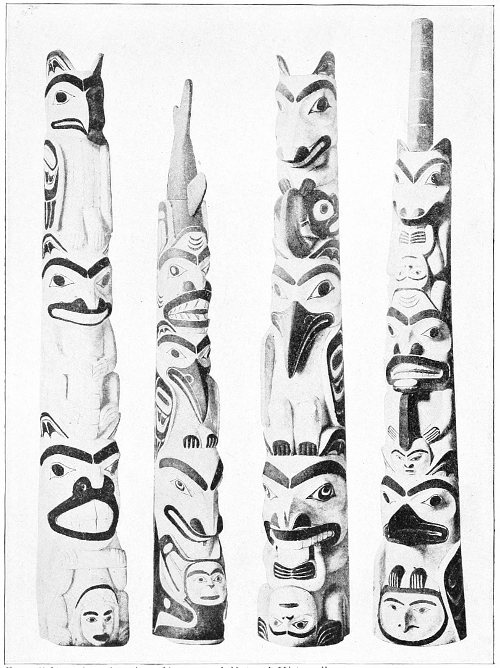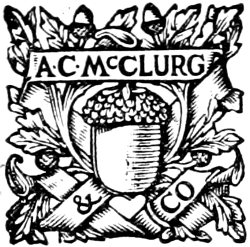

Haida Totem Poles
Indian genealogical trees
From “Memoirs, American Museum of Natural History”
MYTHS AND LEGENDS
OF
BRITISH NORTH AMERICA
SELECTED AND EDITED BY
KATHARINE BERRY JUDSON
ILLUSTRATED

CHICAGO
A. C. McCLURG & CO.
1917
Copyright
A. C. McCLURG & CO.
1917
Published April, 1917
W. P. HALL PRINTING COMPANY, CHICAGO
PREFACE
From the bleak coasts of Labrador and the icyborders of the Frozen Sea, in the east, throughthe river-threaded steppes and plains of theinterior with all their charming lakes, over the tremendous,gleaming white heights of the CanadianRockies, and onwards by cañon and pass to the morepacific climate of the western coast—it is a far sweepof country, this British North America, and occupiedin bygone times by many a tribe of red men.
Yet from eastern coast to western, from the longsouthern boundary to the Arctic Ocean, one finds everywherethe same questioning among these red men.Who was the Someone who had cut and carved therivers and plains and great mountain heights? Whowas the Someone who gave Squirrel a beautiful bushytail which swept his back, and gave Rabbit no tail atall? Why did Someone send the icy winds of winter,the storm winds that shriek around the tepee and rattlethe flaps, howling through the trees and blowing thesnow down the smoke-hole? It seemed impossible thatit was the same One who sent the warm breezes insummer, when the lakes were full of fish and the bushes009laden with berries, when the forests full of game, andlife was easy. Therefore there must be two Powers,one strong and ugly, one beautiful and good, alwaysbattling against each other—the universal human beliefin both good and evil.
Indian myths and legends are the efforts of the redmen to answer these questions, as well as to interestand amuse each other in the long winter evenings whenthe fires burned brightly in the tepees and the carvedplumstone dice were thrown. Men forgot their gamesand women the beading of the moccasin, while childrenlistened intently, as the story tellers of the camprelated, with dramatic gestures, stories of the Days ofthe Grandfathers, in the beginning of the Newness ofThings. Nothing was too large or too small to comewithin the bounds of their beliefs, or within the playof their fancy.
As in all other volumes of this series, only the quaint,the pure, and the beautiful, has been taken from thetales of the Indians. Any one wishing pure ethnology,good and bad together, would do better to go to ethnologicalreports.
The Indians omitted many stories we wish they hadtold. There are few references to the snowy mountains,probably because of their belief that all above thesnowline was governed by vague, misty, but powerful...